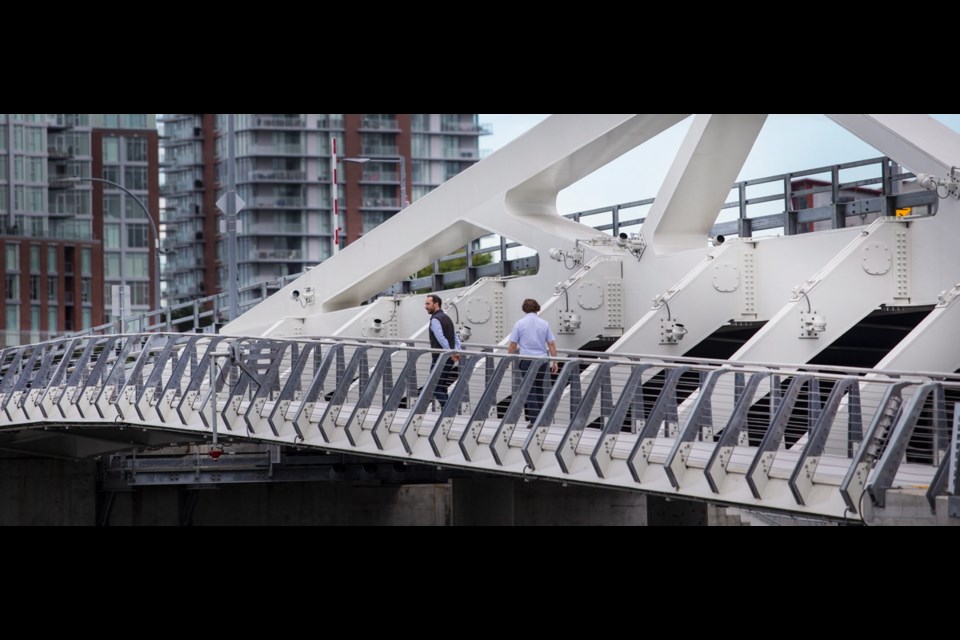It didn’t take long for the south walkway on the Johnson Street Bridge to start earning accolades.
“I think it’s fabulous,” said Carol Harrison, out for a morning stroll on Wednesday. “It’s really, really super.”
Being separate from bike traffic is a bonus, she said.
Ross McLaughlin said he liked what he saw of the walkway as he pushed his bike toward downtown.
“So far everybody seems to be enjoying it,” he said. “You meet a lot of people, too.”
The bridge is a having a positive effect overall, McLaughlin said. “It’s made west Victoria part of the city now.”
Installation of the walkway was put off while the old Johnson Street Bridge was disassembled. The new pedestrian zone opened Wednesday at 6:30 a.m.
“This is the final point of the bridge work itself,” said Jonathan Huggett, director of the $106-million bridge project.
There is also a cyclist and pedestrian walkway on the north side of the bridge. It opened when the bridge opened to traffic on March 31.
“We want, where possible, pedestrians on [the south] side, cyclists on the other side,” Huggett said. “It’s working out really well. I guess the pedestrians like it because they can just stand around and talk and look and they’re not in fear of being run over by a cyclist.”
Adjoining the walkway is a viewing area where the mechanics of the bridge can be seen when it is raised for marine traffic.
“To me, as an engineer, that’s what I really like, the public being involved in a project, being able to touch it, see it, feel it,” Huggett said.
He said there a few “deficiencies” to correct on the bridge, but nothing big to worry about.
“They’re just minor issues that have to be corrected, bits of handrail that aren’t the standard I want to see.”
The fendering, or protective barriers, where the bridge structure meets the water is not completed. Grass, trees and street furniture will be added, along with terracing near the Delta Ocean Pointe Hotel.
Another initiative, the extension of David Foster Way under the eastern end of the bridge, has been put out to tender.
“There’s going to be, over the next years, lots of activity down here,” Huggett said.
Portions of the old Johnson Street Bridge’s concrete base remain next to the new walkway. Huggett said they will not be taken out.
“There’s a huge amount of concrete, but they also provide great protection for the new bridge,” he said. “It does have the potential in the future, of course, that you could put a deck over it and have another open space if you wanted to.”
Huggett said he knows every detail of the finished product.
“I could probably tell you a story about every nut and bolt that was the subject of a meeting somewhere that we had on some occasion.”
PCL Constructors Westcoast Ltd., the bridge contractor, has officially wrapped up after 5 1Ú2 years at the site, Huggett said. “So a long contract for what must seem like a small bridge, but it was a complicated bridge.”
Hundreds of technical specialists were involved.
Huggett has likened the bridge to a Swiss watch, due to the complexities of issues such as putting together the steel components and assembling the inner workings.
One thing Huggett said he would have changed about the project, if he could, would be to have had more advance design work completed.
“I think if we’d had more of the design detailed out before we started, that would have helped,” he said. “We often found ourselves designing this thing as we went, which is not the ideal way to do a bridge, particularly one as complex as this.”
The cost of the bridge was estimated at $63 million in 2009, and had grown to $92.8 million when the contract was awarded to PCL in 2012. Construction got underway in May 2013. The bridge was initially scheduled to be completed by Sept. 30, 2015, but was delayed due, in part, to problems with steel fabrication.



